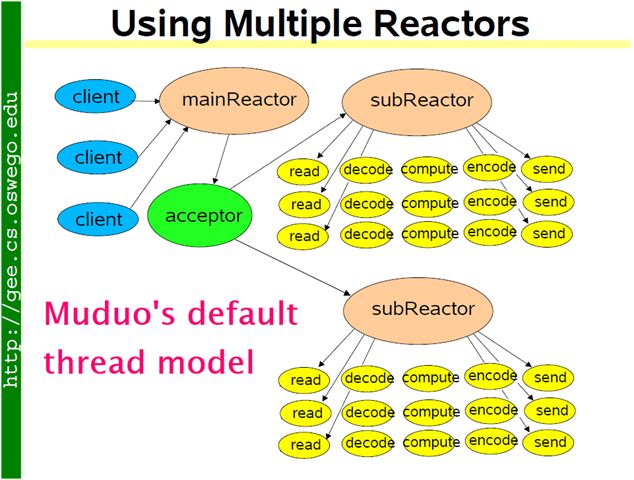Muduo源码阅读
最近简单读了下muduo的源码,本文对其主要实现/结构简单总结下。
muduo的主要源码位于net文件夹下,base文件夹是一些基础代码,不影响理解网络部分的实现。muduo主要类包括:
- EventLoop
- Channel
- Poller
- TcpConnection
- TcpClient
- TcpServer
- Connector
- Acceptor
- EventLoopThread
- EventLoopThreadPool
其中,Poller(及其实现类)包装了Poll/EPoll,封装了OS针对设备(fd)的操作;Channel是设备fd的包装,在muduo中主要包装socket;TcpConnection抽象一个TCP连接,无论是客户端还是服务器只要建立了网络连接就会使用TcpConnection;TcpClient/TcpServer分别抽象TCP客户端和服务器;Connector/Acceptor分别包装TCP客户端和服务器的建立连接/接受连接;EventLoop是一个主控类,是一个事件发生器,它驱动Poller产生/发现事件,然后将事件派发到Channel处理;EventLoopThread是一个带有EventLoop的线程;EventLoopThreadPool自然是一个EventLoopThread的资源池,维护一堆EventLoopThread。
阅读库源码时可以从库的接口层着手,看看关键功能是如何实现的。对于muduo而言,可以从TcpServer/TcpClient/EventLoop/TcpConnection这几个类着手。接下来看看主要功能的实现:
建立连接
TcpClient::connect
-> Connector::start
-> EventLoop::runInLoop(Connector::startInLoop...
-> Connector::connect
EventLoop::runInLoop接口用于在this所在的线程运行某个函数,这个后面看下EventLoop的实现就可以了解。 网络连接的最终建立是在Connector::connect中实现,建立连接之后会创建一个Channel来代表这个socket,并且绑定事件监听接口。最后最重要的是,调用Channel::enableWriting。Channel有一系列的enableXX接口,这些接口用于标识自己关心某IO事件。后面会看到他们的实现。
Connector监听的主要事件无非就是连接已建立,用它监听读数据/写数据事件也不符合设计。TcpConnection才是做这种事的。
客户端收发数据
当Connector发现连接真正建立好后,会回调到TcpClient::newConnection,在TcpClient构造函数中:
connector_->setNewConnectionCallback(
boost::bind(&TcpClient::newConnection, this, _1));
TcpClient::newConnection中创建一个TcpConnection来代表这个连接:
TcpConnectionPtr conn(new TcpConnection(loop_,
connName,
sockfd,
localAddr,
peerAddr));
conn->setConnectionCallback(connectionCallback_);
conn->setMessageCallback(messageCallback_);
conn->setWriteCompleteCallback(writeCompleteCallback_);
...
conn->connectEstablished();
并同时设置事件回调,以上设置的回调都是应用层(即库的使用者)的接口。每一个TcpConnection都有一个Channel,毕竟每一个网络连接都对应了一个socket fd。在TcpConnection构造函数中创建了一个Channel,并设置事件回调函数。
TcpConnection::connectEstablished函数最主要的是通知Channel自己开始关心IO读取事件:
void TcpConnection::connectEstablished()
{
...
channel_->enableReading();
这是自此我们看到的第二个Channel::enableXXX接口,这些接口是如何实现关心IO事件的呢?这个后面讲到。
muduo的数据发送都是通过TcpConnection::send完成,这个就是一般网络库中在不使用OS的异步IO情况下的实现:缓存应用层传递过来的数据,在IO设备可写的情况下尽量写入数据。这个主要实现在TcpConnection::sendInLoop中。
TcpConnection::sendInLoop(....) {
...
// if no thing in output queue, try writing directly
if (!channel_->isWriting() && outputBuffer_.readableBytes() == 0) // 设备可写且没有缓存时立即写入
{
nwrote = sockets::write(channel_->fd(), data, len);
}
...
// 否则加入数据到缓存,等待IO可写时再写
outputBuffer_.append(static_cast<const char*>(data)+nwrote, remaining);
if (!channel_->isWriting())
{
// 注册关心IO写事件,Poller就会对写做检测
channel_->enableWriting();
}
...
}
当IO可写时,Channel就会回调TcpConnection::handleWrite(构造函数中注册)
void TcpConnection::handleWrite()
{
...
if (channel_->isWriting())
{
ssize_t n = sockets::write(channel_->fd(),
outputBuffer_.peek(),
outputBuffer_.readableBytes());
服务器端的数据收发同客户端机制一致,不同的是连接(TcpConnection)的建立方式不同。
服务器接收连接
服务器接收连接的实现在一个网络库中比较重要。muduo中通过Acceptor类来接收连接。在TcpClient中,其Connector通过一个关心Channel可写的事件来通过连接已建立;在Acceptor中则是通过一个Channel可读的事件来表示有新的连接到来:
Acceptor::Acceptor(....) {
...
acceptChannel_.setReadCallback(
boost::bind(&Acceptor::handleRead, this));
...
}
void Acceptor::handleRead()
{
...
int connfd = acceptSocket_.accept(&peerAddr); // 接收连接获得一个新的socket
if (connfd >= 0)
{
...
newConnectionCallback_(connfd, peerAddr); // 回调到TcpServer::newConnection
TcpServer::newConnection中建立一个TcpConnection,并将其附加到一个EventLoopThread中,简单来说就是给其配置一个线程:
void TcpServer::newConnection(int sockfd, const InetAddress& peerAddr)
{
...
EventLoop* ioLoop = threadPool_->getNextLoop();
TcpConnectionPtr conn(new TcpConnection(ioLoop,
connName,
sockfd,
localAddr,
peerAddr));
connections_[connName] = conn;
...
ioLoop->runInLoop(boost::bind(&TcpConnection::connectEstablished, conn));
IO的驱动
之前提到,一旦要关心某IO事件了,就调用Channel::enableXXX,这个如何实现的呢?
class Channel {
...
void enableReading() { events_ |= kReadEvent; update(); }
void enableWriting() { events_ |= kWriteEvent; update(); }
void Channel::update()
{
loop_->updateChannel(this);
}
void EventLoop::updateChannel(Channel* channel)
{
...
poller_->updateChannel(channel);
}
最终调用到Poller::upateChannel。muduo中有两个Poller的实现,分别是Poll和EPoll,可以选择简单的Poll来看:
void PollPoller::updateChannel(Channel* channel)
{
...
if (channel->index() < 0)
{
// a new one, add to pollfds_
assert(channels_.find(channel->fd()) == channels_.end());
struct pollfd pfd;
pfd.fd = channel->fd();
pfd.events = static_cast<short>(channel->events()); // 也就是Channel::enableXXX操作的那个events_
pfd.revents = 0;
pollfds_.push_back(pfd); // 加入一个新的pollfd
int idx = static_cast<int>(pollfds_.size())-1;
channel->set_index(idx);
channels_[pfd.fd] = channel;
可见Poller就是把Channel关心的IO事件转换为OS提供的IO模型数据结构上。通过查看关键的pollfds_的使用,可以发现其主要是在Poller::poll接口里。这个接口会在EventLoop的主循环中不断调用:
void EventLoop::loop()
{
...
while (!quit_)
{
activeChannels_.clear();
pollReturnTime_ = poller_->poll(kPollTimeMs, &activeChannels_);
...
for (ChannelList::iterator it = activeChannels_.begin();
it != activeChannels_.end(); ++it)
{
currentActiveChannel_ = *it;
currentActiveChannel_->handleEvent(pollReturnTime_); // 获得IO事件,通知各注册回调
}
整个流程可总结为:各Channel内部会把自己关心的事件告诉给Poller,Poller由EventLoop驱动检测IO,然后返回哪些Channel发生了事件,EventLoop再驱动这些Channel调用各注册回调。
从这个过程中可以看出,EventLoop就是一个事件产生器。
线程模型
在muduo的服务器中,muduo的线程模型是怎样的呢?它如何通过线程来支撑高并发呢?其实很简单,它为每一个线程配置了一个EventLoop,这个线程同时被附加了若干个网络连接,这个EventLoop服务于这些网络连接,为这些连接收集并派发IO事件。
回到TcpServer::newConnection中:
void TcpServer::newConnection(int sockfd, const InetAddress& peerAddr)
{
...
EventLoop* ioLoop = threadPool_->getNextLoop();
...
TcpConnectionPtr conn(new TcpConnection(ioLoop, // 使用这个选择到的线程中的EventLoop
connName,
sockfd,
localAddr,
peerAddr));
...
ioLoop->runInLoop(boost::bind(&TcpConnection::connectEstablished, conn));
注意TcpConnection::connectEstablished是如何通过Channel注册关心的IO事件到ioLoop的。
极端来说,muduo的每一个连接线程可以只为一个网络连接服务,这就有点类似于thread per connection模型了。
网络模型
传说中的Reactor模式,以及one loop per thread,基于EventLoop的作用,以及线程池与TcpConnection的关系,可以醍醐灌顶般理解以下这张muduo的网络模型图了:
总结
本文主要对muduo的主要结构及主要机制的实现做了描述,其他如Buffer的实现、定时器的实现大家都可以自行研究。muduo的源码很清晰,通过源码及配合陈硕博客上的内容可以学到一些网络编程方面的经验。
